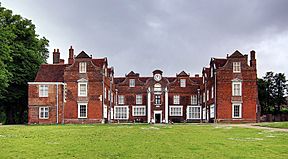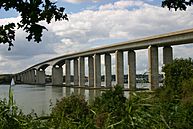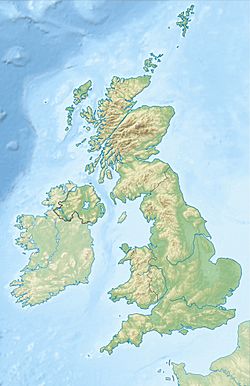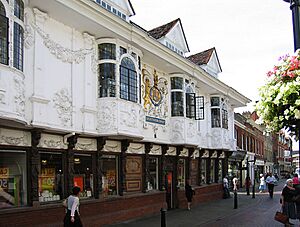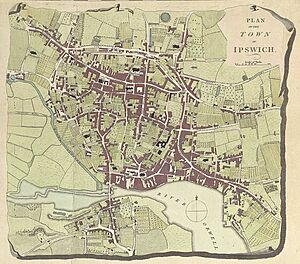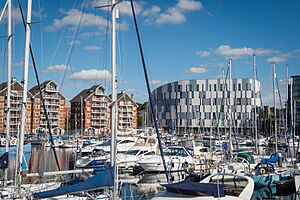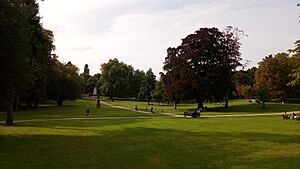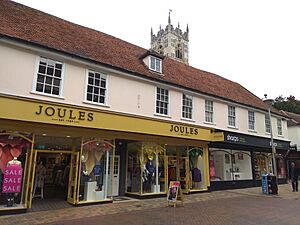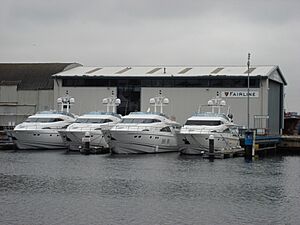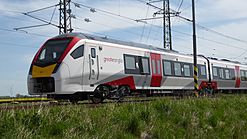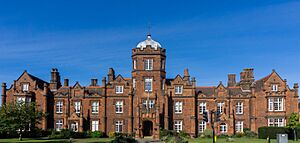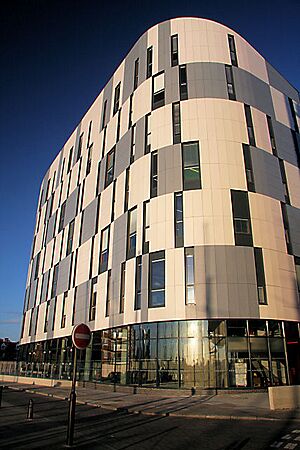Ipswich facts for kids
Quick facts for kids
Ipswich
Borough of Ipswich
|
||
|---|---|---|
|
|
||
|
||
| Motto(s):
Munia civitatis decus civium
(The functions of citizenship are the glory of the citizens) |
||
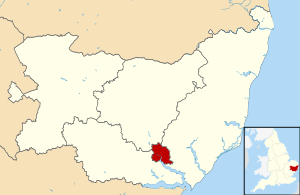
Location within Suffolk
|
||
| Sovereign state | United Kingdom | |
| Country | England | |
| Region | East of England | |
| County | Suffolk | |
| District | Ipswich | |
| Areas of the town | ||
| Government | ||
| • Type | Leader and Cabinet | |
| • Body | Ipswich Borough Council | |
| Area | ||
| • Total | 15.22 sq mi (39.42 km2) | |
| Population | ||
| • Total | District ranked 162nd 133,384 |
|
| • The town, 2011 census | 144,957 | |
| • Built up area, 2011 census | 178,835 | |
| Ethnicity (2021) | ||
| • Ethnic groups |
List
|
|
| Religion (2021) | ||
| • Religion |
List
45.3% no religion
42.2% Christianity 8.6% other 3.9% Islam |
|
| Postcode |
IP
|
|
| Area code(s) | 01473 | |
| Vehicle registration area code | AV, AW, AX, AY | |
| ONS code | 42UD | |
Ipswich (![]() i/ˈɪpswɪtʃ/) is a historic port town in Suffolk, England. It's the main town in Suffolk and the third largest in East Anglia, after Peterborough and Norwich. Ipswich is about 50 miles (80 km) northeast of London. In 2011, it had a population of 144,957 people. The larger Ipswich built-up area includes nearby towns like Kesgrave and Woodbridge.
i/ˈɪpswɪtʃ/) is a historic port town in Suffolk, England. It's the main town in Suffolk and the third largest in East Anglia, after Peterborough and Norwich. Ipswich is about 50 miles (80 km) northeast of London. In 2011, it had a population of 144,957 people. The larger Ipswich built-up area includes nearby towns like Kesgrave and Woodbridge.
The town was first called Gippeswic in medieval times. It has been lived in continuously since the Saxon period. This makes it one of the oldest towns in the United Kingdom. Ipswich was very important for trade throughout history. Its old dock, the Ipswich Waterfront, was once the biggest and most important in the Kingdom.
Ipswich has different areas, but the town centre and the waterfront are the most popular. The town centre has shops and the historic town square, called the Cornhill. The waterfront is south of the town centre, along the River Orwell. It has a marina, fancy yachts, tall apartment buildings, and many restaurants and cafes. The University of Suffolk campus is also located here.
Ipswich is surrounded by two beautiful Areas of Outstanding Natural Beauty (AONB). These are the Suffolk Coast and Heaths and Dedham Vale. Many tourists visit the town, with 3.5 million visitors in 2016. In 2020, TripAdvisor even named Ipswich an "emerging global tourist destination."
Contents
History of Ipswich
Ipswich is one of England's oldest towns. People believe it's the oldest town continuously settled and developed by the English. Its history goes all the way back to early Anglo-Saxon times.
Early Settlements
A large Roman fort was once located near Felixstowe, about 13 miles (21 km) away. This fort was part of Britain's coastal defenses. The biggest Roman villa in Suffolk, possibly an administrative building, was found at Castle Hill in north-west Ipswich.
The Middle Ages
The modern town of Ipswich began to form in Anglo-Saxon times (7th–8th centuries). It grew around the Port of Ipswich. As countries in north-western Europe recovered after the Roman Empire fell, trade across the North Sea became very important. Ipswich, then called Gipeswic, became a key port for the Kingdom of East Anglia. Early goods imported here date back to the time of King Rædwald (616–624). His famous ship-burial and treasure might be found at Sutton Hoo, nearby. The Ipswich Museum has copies of the Roman Mildenhall and Sutton Hoo treasures. You can also see Anglo-Saxon weapons and jewellery there.
Around 700 AD, potters from the Netherlands settled in Ipswich. They started the first large-scale potteries in England since Roman times. Their pottery was traded all over England, and this industry was unique to Ipswich for 200 years. As the town grew richer, a new area was planned in the Buttermarket around 720 AD. Ipswich was becoming very important both in England and internationally. Some of its old street layouts are still visible today.
After an invasion in 869, Ipswich was ruled by the Vikings. They likely built the earth walls around the town centre around 900 AD to protect it. However, the English eventually recaptured it. Ipswich had its own mint from the 970s, making coins with the abbreviation Gipes. This continued until about 1215.
In 1200, King John gave Ipswich its first charter. This set up the town's local government. Ipswich then controlled a large area around it, called the Liberty of Ipswich.
Over the next four centuries, Ipswich became very wealthy. It had five large religious houses, including two Augustinian Priories. There were also several hospitals, like the leper hospital of St Mary Magdalene.
During the Middle Ages, the Marian Shrine of Our Lady of Grace was a famous place for pilgrimage. Even King Henry VIII and Katherine of Aragon visited it. During the Reformation, the statue was taken to London to be burned.
Around 1380, Geoffrey Chaucer made fun of Ipswich merchants in his book The Canterbury Tales. Thomas Wolsey, who later became a powerful cardinal, was born in Ipswich in 1473. He was a close friend of Henry VIII and founded a college in Ipswich in 1528. Wolsey is still one of Ipswich's most famous people.
Early Modern Times
From the 14th to 17th centuries, Ipswich was a trading post for the Hanseatic League. Its port was used for trade with the Baltic Sea area.
During the time of Queen Mary, the Ipswich Martyrs were burned at the stake on the Cornhill. They were punished for their Protestant beliefs. A monument in Christchurch Park remembers this event. Ipswich was also a centre for printing and selling books in the 16th century. From 1611 to 1634, many people left Ipswich to move to New England in America. This was encouraged by a local minister, Samuel Ward.

The famous painter Thomas Gainsborough lived and worked in Ipswich. In 1835, Charles Dickens stayed in Ipswich. He used the town as a setting for parts of his novel The Pickwick Papers. The hotel where he stayed, now called the Great White Horse Hotel, was built in 1518. Dickens made it famous in his book, describing its winding corridors.
19th and 20th Centuries
In 1824, Dr. George Birkbeck helped start one of the first Mechanics' Institutes in Ipswich. This institute, which is still open today, is a reading room and library. It's located at 15 Tavern Street.
In the mid-1800s, coprolite (fossilised animal dung) was found near Ipswich. This material was used to make fertiliser, which led to the creation of the Fisons fertiliser business.
The Tolly Cobbold brewery, rebuilt in 1894–96, is a beautiful Victorian brewery. The Cobbold family had a brewery in Ipswich from 1746 until 2002. Felix Thornley Cobbold gave Christchurch Mansion to the town in 1896.
Ipswich was bombed by German Zeppelins during World War I. However, the worst damage happened during World War II German bombing raids. The docks area was especially hit hard. Ninety civilians died in Ipswich during the war. The last bombs fell on Seymour Road on March 2, 1945, killing nine people.
The Willis Building is a modern glass building owned by Willis. Designed by Norman Foster, it was built in 1974. In 1991, it became the youngest building in Britain to be given Grade I listed status, meaning it's very important historically or architecturally.
In September 1993, Ipswich became a twin town with Arras, France. A square in the new Buttermarket area was named Arras Square to celebrate this friendship.
Ipswich used to have a municipal airport that opened in 1929. It was closed in 1996, and the land was used to build houses for the Ravenswood estate.
21st Century Ipswich
Ipswich has seen a lot of new building in the 21st century. Much of this construction has happened around the old industrial dock, now called the Ipswich Waterfront. This area has been transformed into a cultural hub. It now has fancy restaurants, a special hotel, and the new University of Suffolk. The tall buildings of the Regatta Quay development are among the tallest in Ipswich. The Mill, a building with many uses, is currently the tallest in Suffolk.
Ipswich has tried several times to become a city, but hasn't succeeded yet. It doesn't have a cathedral, so the Bishop of St Edmundsbury and Ipswich is based in Bury St Edmunds.
Ipswich is the largest town in Suffolk. It is also the third-largest population centre in East Anglia, after Peterborough and Norwich.
Areas of Ipswich
The waterfront area is now mostly for fun and relaxation. It has many new apartment buildings and a university campus. Businesses here include luxury boat services and a timber merchant. Other industries are located south of the wet dock. The area was flooded in 2013 during a big tidal surge. In 2019, a large flood gate was opened to protect the "New Cut" area. This flood barrier, similar to the Thames Barrier, cost £67 million.
The Ipswich Village Development, started in 2002, is home to the offices of Suffolk County Council and Ipswich Borough Council.
Holywells Ward, Ipswich is the area around Holywells Park. This is a 67-acre (27-hectare) public park near the docks. It was even painted by Thomas Gainsborough. Alexandra Park is another park close to the waterfront, next to the University of Suffolk.
Other areas outside the town centre include California, Castle Hill, Chantry, Gainsborough, Pinewood, and Ravenswood (built on an old airfield).
To the east of town is Trinity Park. This is where the annual Suffolk Show takes place. The "Trinity" refers to three animals from Suffolk: the Red Poll cattle, the strong Suffolk Punch horse, and the black-faced Suffolk sheep.
Culture in Ipswich
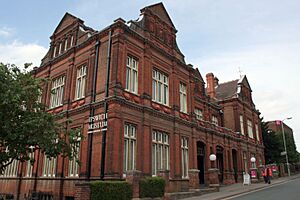
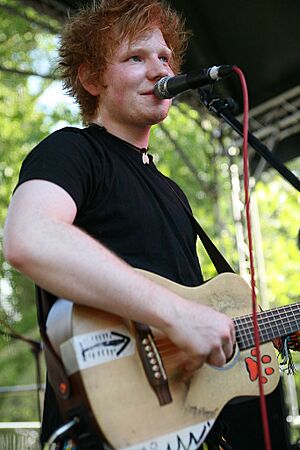
Ipswich has many artists and art galleries. The main galleries are at Christchurch Mansion, the Town Hall, Ancient House, and the Artists' Gallery. The town also has many public sculptures. The local council encourages new public artworks. Ipswich has three museums: Ipswich Museum, the Ipswich Transport Museum, and Christchurch Mansion.
The New Wolsey Theatre is a 400-seat theatre on Civic Drive. The New Wolsey Company took over the theatre in 2000.
DanceEast helps promote dance in the East of England. They have new, specially built dance facilities at the waterfront. These are the first of their kind in the region, costing about £8 million.
The Spill Festival of Performance started in Ipswich in 2007. It takes place in London and Ipswich every other year. In 2018, the festival featured "Clarion Call." This sound installation used audio technology and the voices of women and girls to create a huge soundscape. It explored local history from World War I.
Eastern Angles Theatre Company is based at the Sir John Mills Theatre in Ipswich. It's named after the famous actor who lived nearby as a child. The company performs in rural areas and has seasonal shows.
The Ipswich Arts Festival, called 'Ip-art', has been the town's yearly summer arts festival since 2003. It features visual arts, performing arts, literature, film, and music. There's often a free music day in Christchurch Park. The Ipswich Jazz Festival also started in 2015.
Ipswich had a lively punk music scene. The famous grindcore band Extreme Noise Terror formed here in 1985. The town also hosts art and photography exhibitions, film screenings, and workshops.
Media in Ipswich
Television
Ipswich receives TV news from BBC Look East and ITV News Anglia. Both are broadcast from Norwich.
Radio
The town has several local radio stations. BBC Radio Suffolk broadcasts from its studios in Ipswich. Nation Radio Suffolk also has a local show. Ipswich Community Radio started in 2007.
Newspapers
The local daily newspaper is the Ipswich Star. It's a sister paper to the county's daily newspaper, the East Anglian Daily Times.
Buildings in Ipswich
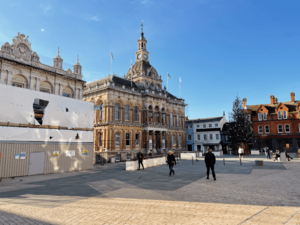

Besides Christchurch Mansion and Ancient House, Ipswich has other important cultural buildings. These include the New Wolsey Theatre and the Regent Theatre. The Regent is the biggest theatre in East Anglia. In 1964, the Beatles even performed there when it was called the Gaumont. The Corn Exchange in King Street was finished in 1882.
Ipswich has several medieval churches. The grandest is St. Mary-le-Tower, which was rebuilt by the Victorians. Holy Trinity Church by the waterfront is rare because it was built during the reign of William IV. Its outside looks simple, but the inside is amazing. The world's oldest set of church bells is in St Lawrence Church.
The Ancient House in the Buttermarket is a great example of an old merchant's house. It has special Tudor pargeting (decorative plasterwork) and unique Ipswich windows.
Modern buildings include Endeavour House (headquarters of Suffolk County Council) and Grafton House (home of Ipswich Borough Council). These are on Russell Road, in an area called the Ipswich Village Development. This area also includes Portman Road stadium. The stadium has hosted many important soccer and rugby union matches.
In the waterfront area, The Mill is the tallest building in East Anglia, with 23 floors.
On the north-west side of Ipswich is Broomhill Pool. This is a Grade II listed Olympic-sized lido (outdoor swimming pool) that opened in 1938. It closed in 2002, but there's a campaign to restore and reopen it.
Local Government
Ipswich is governed by a two-level council system. Ipswich Borough Council handles local services like rubbish collection, housing, and planning. Suffolk County Council provides county-wide services such as transport, education, and social services.
The town is covered by two parliamentary areas. Ipswich is represented by Labour MP Jack Abbott. Central Suffolk & North Ipswich is represented by Conservative MP Patrick Spencer.
In 2006, the borough council started talking about becoming a unitary authority. This would mean one council would handle all local government duties. Ipswich, Norwich, Exeter, and Oxford worked together to campaign for this status. In 2007, Ipswich was one of 16 councils chosen for consideration. However, the plans were later delayed.
Industry in Ipswich
Since Ipswich is the main town in agricultural Suffolk, its industries have strong links to farming. Ransomes, Sims & Jefferies Ltd was a very famous agricultural equipment maker in the town. They built the world's first commercial motorised lawnmower in 1902. Ransomes & Rapier also made railway equipment and cranes. There was a sugar beet factory in Ipswich for many years, but it closed in 2001. This farming connection is why the local football club is nicknamed "The Tractor Boys."
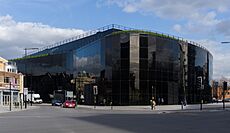
The British Telecom Research Laboratories opened east of the town in 1975. This area is now a science park called Adastral Park. It used to be RAF Martlesham Heath, a World War II airfield. Part of the old airfield is now the police headquarters for Suffolk Constabulary.
A major industry in Ipswich is insurance. Big companies like Axa and Willis Towers Watson have a strong presence here. Because there are many skilled workers, other businesses like call centres have also set up in Ipswich.
Ipswich is one of the Haven ports and is still a busy working port. It handles millions of tonnes of cargo every year. HMS Grafton and HMS Orwell (named after the river) have special connections with Ipswich.
Transport in Ipswich
Ipswich railway station is on the main train line from London to Norwich. It also connects to Lowestoft and Felixstowe. Greater Anglia operates trains from Ipswich to cities like London, Cambridge, and Norwich. Ipswich also has a smaller station at Derby Road.
Ipswich is close to the A12 and the A14 roads. The Orwell Bridge carries the A14 over the River Orwell. This bridge connects Ipswich to the Port of Felixstowe, a major container port about 12 miles (19 km) to the east.
Bus services in Ipswich are run by Ipswich Buses, First Eastern Counties, and other companies. Town buses mainly leave from Tower Ramparts bus station. Regional buses leave from the Ipswich Old Cattle Market bus station. Ipswich Airport closed in 1996.
Ipswich is part of Sustrans's National Cycle Route 1 and National Cycle Route 51, which are routes for cyclists.
Sport in Ipswich
Ipswich's only professional association football (soccer) club is Ipswich Town. It was founded in 1878 and plays at the Portman Road stadium, which holds 30,300 fans. They will play in the Premier League from the 2024-25 season. Ipswich Town has a strong rivalry with Norwich City. The club was home to two very successful England managers: Alf Ramsey and Bobby Robson. Ipswich won the First Division title in 1961–62, the 1978 FA Cup, and the 1981 UEFA Cup. They are also undefeated at home in all European competitions.
Ipswich also has several other football clubs, like Ipswich Wanderers. The town has two rugby union teams, Ipswich RFC and Ipswich YM RUFC, and one rugby league team, Ipswich Rhinos. The Ipswich Cardinals are an American football team.
The speedway team, the Ipswich Witches, has raced at Foxhall Stadium since 1951. They have won the top league title four times. The stadium also hosts Hot Rod, Stock Car, and Banger racing events.
Ipswich Gymnastics Centre is one of only three Olympic-approved gymnastics facilities in the UK.
Ipswich has a long history of public swimming. In the 1830s, there were at least three swimming spots. Fore Street Swimming Pool opened in 1894 and is the second oldest swimming pool still in use in the UK. Crown Pools opened in 1984 and is still used today. The most successful swimmer from Ipswich Swimming Club is World Championship gold medalist Karen Pickering.
Ipswich used to have a racecourse for horse racing.
Education in Ipswich
Schools
State-funded secondary schools in Ipswich include Copleston High School, St Alban's Catholic High School, and Northgate High School. There are also academies like Ipswich Academy and Chantry Academy. Ipswich is also home to several independent schools. These include Royal Hospital School and Ipswich School (both for boys and girls). Ipswich High School now accepts both girls and boys. St Joseph's College is a Catholic school that also hosts an international summer camp.
Colleges and Universities
Suffolk New College is a further education college in Ipswich. It serves students from the town and surrounding areas. There is also a sixth form college called One.
Ipswich is home to the University of Suffolk, which is Suffolk's first university. It started in 2007 as University Campus Suffolk. It became a full university in 2016 and changed its name to the University of Suffolk.
Climate in Ipswich
Ipswich has an oceanic climate, like the rest of the British Isles. This means temperatures don't change too much, and rain is spread out throughout the year. Summers are relatively warm. The highest temperature ever recorded was 35.2 °C (95.4 °F) in August 2003.
Winters are mild, but frosts can happen. The lowest temperature recorded was −16.1 °C (3.0 °F) in January 1963.
Ipswich doesn't get a lot of rain, averaging about 569.3mm per year. This is typical for much of East Anglia. The area also gets a good amount of sunshine, which is common for southern England.
Famous People from Ipswich
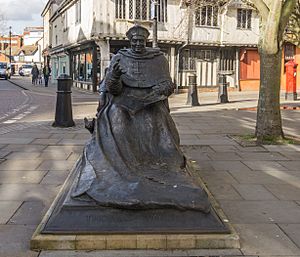
Many famous people have connections to Ipswich. The Tudor Cardinal Thomas Wolsey was born here. The artist Thomas Gainsborough and cartoonist "Giles" both worked in the town. Horatio, Lord Nelson, a famous admiral, was also connected to Ipswich. Margaret Catchpole started her adventurous life here.
Alf Ramsey and Bobby Robson were both very successful managers of Ipswich Town. Sarah Trimmer, a writer and critic of children's books, was born in Ipswich in 1741. She was one of the first to include pictures and animals in children's literature.
Actor Sam Claflin, known for The Hunger Games and Peaky Blinders, was born in Ipswich. Actor and director Richard Ayoade, from The IT Crowd, grew up here. Musician Nandi Bushell also grew up in Ipswich.
Jeremy Wade, an extreme angler who hosts TV shows like River Monsters, was born in Ipswich.
Twin Towns
Ipswich is twinned with:
- Arras, France, since 1994
See also
 In Spanish: Ipswich para niños
In Spanish: Ipswich para niños


